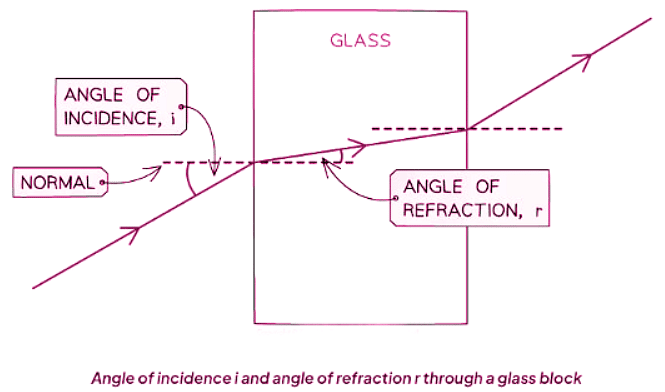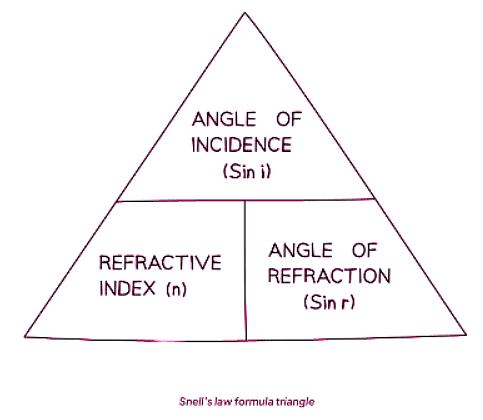Class 10 Exam > Class 10 Notes > Physics for GCSE/IGCSE > Snell's Law
Snell's Law | Physics for GCSE/IGCSE - Class 10 PDF Download
Refractive Index
- The refractive index is a number associated with the speed of light in a material, always slower than in a vacuum.
- The refractive index is always greater than 1 and varies for different materials.
- Objects with higher optical density, like diamond (refractive index ~2.4), have higher refractive indices.
- Objects with lower optical density, like glass (refractive index ~1.5), have lower refractive indices.
- Refractive index is a ratio and does not have any units associated with it.
Snell's Law
- When light transitions into a denser medium such as glass, it decelerates and bends towards the normal line.
- The extent of light bending is contingent upon the density of the material.

- Light bending towards the normal: When light travels from a less dense medium (e.g., air) to a more dense medium (e.g., glass), the angle of refraction is less than the angle of incidence.
- Light bending away from the normal: When light travels from a more dense medium (e.g., glass) to a less dense medium (e.g., air), the angle of refraction is greater than the angle of incidence.
- Snell's Law mathematically describes the relationship between the angles of incidence and refraction.

- Where:
- The refractive index (n) of the material affects how much light bends.
- The angle of incidence (i) is the angle at which light enters the medium.
- The angle of refraction (r) is the angle at which light changes direction upon entering the new medium.
- 'Sin' in Snell's Law refers to the trigonometric function 'sine,' typically found on scientific calculators.
- This equation can be rearranged with the help of the formula triangle:

Question for Snell's LawTry yourself: What is the refractive index?View Solution
The document Snell's Law | Physics for GCSE/IGCSE - Class 10 is a part of the Class 10 Course Physics for GCSE/IGCSE.
All you need of Class 10 at this link: Class 10
|
126 videos|194 docs|35 tests
|
FAQs on Snell's Law - Physics for GCSE/IGCSE - Class 10
| 1. What is Snell's Law and how is it related to the refractive index? |  |
Ans. Snell's Law is a formula that describes how light bends or refracts when it passes from one medium to another. The formula is n1sinθ1 = n2sinθ2, where n1 and n2 are the refractive indices of the two media and θ1 and θ2 are the angles of incidence and refraction, respectively.
| 2. How can Snell's Law be used to calculate the angle of refraction when light passes from one medium to another? |  |
Ans. To calculate the angle of refraction using Snell's Law, you need to know the refractive indices of the two media and the angle of incidence. Plug these values into the formula n1sinθ1 = n2sinθ2 and solve for the angle of refraction.
| 3. What is the refractive index of a medium and how does it affect the speed of light in that medium? |  |
Ans. The refractive index of a medium is a measure of how much the speed of light is reduced when it passes through that medium. A higher refractive index means that light travels slower in that medium compared to a vacuum.
| 4. What is the significance of the Snell's Law formula triangle in calculating angles of incidence and refraction? |  |
Ans. The Snell's Law formula triangle helps in visually organizing the variables involved in the formula (n1sinθ1 = n2sinθ2) and makes it easier to solve for the unknown angles of incidence and refraction.
| 5. How can one determine the refractive index of a medium experimentally using Snell's Law? |  |
Ans. To determine the refractive index of a medium experimentally, one can vary the angle of incidence and measure the corresponding angle of refraction. By applying Snell's Law and using different pairs of angles, the refractive index of the medium can be calculated.
Related Searches
















